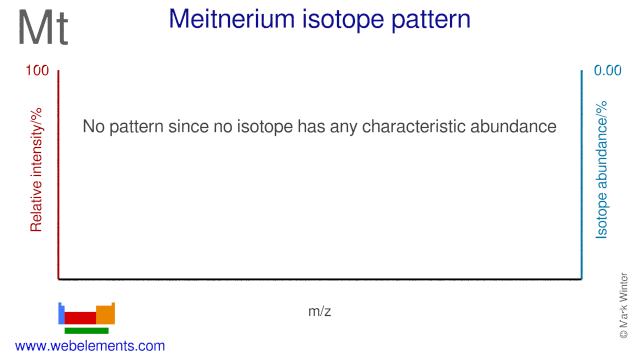Meitnerium - 109Mt: the essentials
- Name: meitnerium
- Symbol: Mt
- Atomic number: 109
- Relative atomic mass (Ar): [ 278 ] (longest lived isotope)
- Standard state: presumably a solid at 298 K
- Appearance: unknown, but probably metallic and silvery white or grey in appearance
- Classification: Metallic
- Group in periodic table: 9
- Group name: (none)
- Period in periodic table: 7
- Block in periodic table: d
- Shell structure: 2.8.18.32.32.15.2
- CAS Registry: 54038-01-6
Meitnerium atoms have 109 electrons and the shell structure is 2.8.18.32.32.15.2. The ground state electronic configuration of neutral meitnerium is [Rn].5f14.6d7.7s2 (a guess based upon that of iridium) and the term symbol of meitnerium is 4F9/2 (a guess based upon guessed electronic structure).
Meitnerium: description
Element 109, meitnerium, is a synthetic element that is not present in the environment at all. There is no dispute concerning the name meitnerium for element 109.
The interested reader should consult the on-line version of Creating Super Heavy Elements for a fascinating insight into research on "super-heavy" atoms.
Meitnerium: physical properties
Density of solid: 28200 (predicted) kg m-3
Molar volume: 10 (rough estimate based upon density estimate) cm3
Thermal conductivity: (no data) W m‑1 K‑1
Meitnerium: heat properties
Melting point: (no data) K
Boiling point: (no data) K
Enthalpy of fusion: 20.5 kJ mol-1
Meitnerium: atom sizes
Atomic radius (empirical): (no data) pm
Molecular single bond covalent radius: 129 (coordination number 4) ppm
van der Waals radius: (no data) ppm
Meitnerium: electronegativities
Pauling electronegativity: (no data) (Pauling units)
Allred Rochow electronegativity: (no data) (Pauling units)
Mulliken-Jaffe electronegativity: (no data)
Meitnerium: orbital properties
First ionisation energy: 801 kJ mol‑1
Second ionisation energy: (no data) kJ mol‑1
Third ionisation energy: (no data) kJ mol‑1
Meitnerium: abundances
Universe: (no data) ppb by weight
Crustal rocks: (no data) ppb by weight
Human: (no data) ppb by weight
Meitnerium: crystal structure

Meitnerium: biological data
Human abundance by weight: (no data) ppb by weight
Meitnerium has no biological role.
Meitnerium: uses
Meitnerium: reactions
Reactions of meitnerium as the element with air, water, halogens, acids, and bases where known.
Meitnerium: binary compounds
Binary compounds with halogens (known as halides), oxygen (known as oxides), hydrogen (known as hydrides), and other compounds of meitnerium where known.
Meitnerium: compound properties
Bond strengths; lattice energies of meitnerium halides, hydrides, oxides (where known); and reduction potentials where known.
Meitnerium: history
Meitnerium was discovered by Peter Armbruster, Gottfried Münzenber and their co-workers. in 1982 at Gesellschaft für Schwerionenforschung (GSI) in Darmstadt, Germany.. Origin of name: named after Lise "Meitner", the Austrian physicist.Meitnerium: isotopes

Meitnerium: isolation
Isolation: only a few atoms of element 109, meitnerium, have ever been made. The first atoms were made through a nuclear reaction involving fusion of an isotope of bismuth, 209Bi, with one of iron, 58Fe.
209Bi + 58Fe → 266Mt + 1n
Isolation of an observable quantity of meitnerium has never been achieved, and may well never be. This is because meitnerium decays very rapidly through the emission of α-particles.
